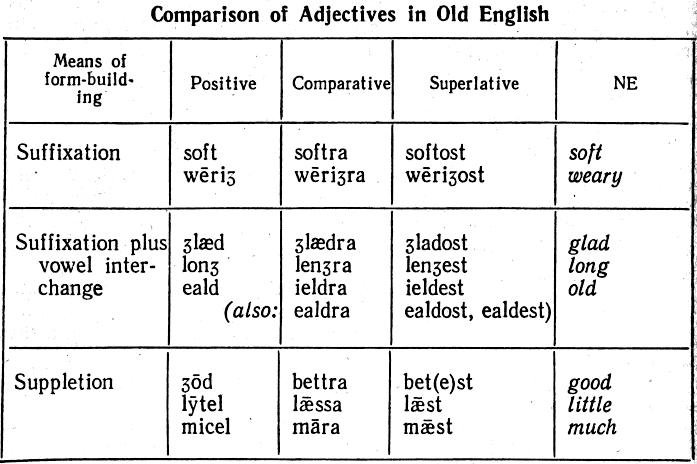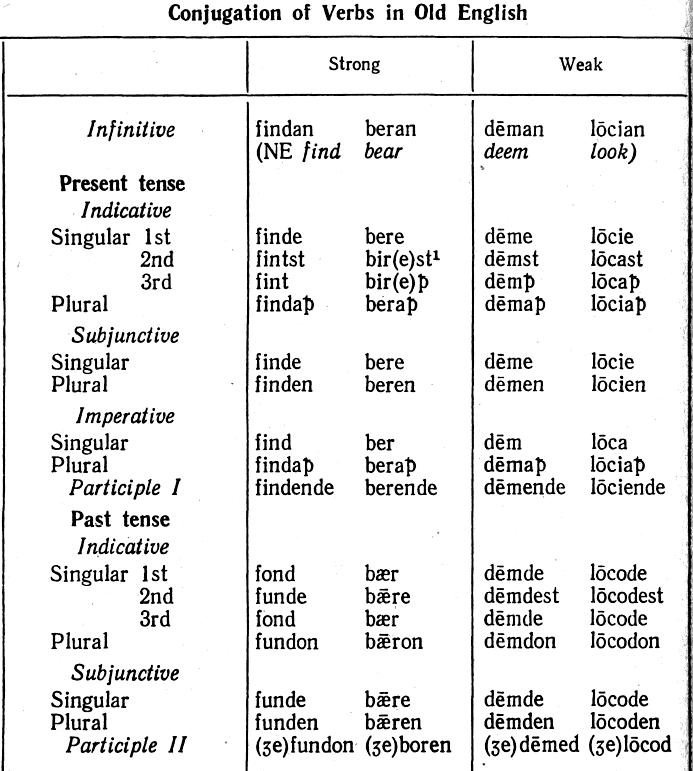
- •Lecture 8 old english grammar Plan
- •Literature
- •Preliminary remarks. Form-Building. Parts of Speech and Grammatical Categories
- •The noun Grammatical Categories. The Use of Cases
- •Morphological Classification of Nouns. Declensions
- •The pronoun
- •Personal Pronouns
- •Other Classes of Pronouns
- •The adjective Grammatical Categories
- •Weak and Strong Declension
- •Degrees of Comparison
- •The verb
- •Grammatical Categories of the Finite Verb
- •Grammatical Categories of the Verbals
- •Morphological Classification of Verbs
- •Strong Verbs
- •Weak Verbs
- •Minor Groups of Verbs
- •The Phrase. Noun, Adjective and Verb Patterns
- •Compound and Complex Sentences. Connectives
- •Word Order
Degrees of Comparison
Like adjectives in other languages, most OE adjectives distinguished between three degrees of comparison: positive, comparative and superlative. The regular means used to form the comparative and the superlative from the positive were the suffixes -ra and-est/ost. Sometimes suffixation was accompanied by an interchange of the root-vowel (see Table 8).
Table 8

The root-vowel interchanges in long, eald, ʒlæd go back to different sources. The variation [a~ æ] is a purely phonetic phenomenon; retraction of [æ] before the back vowel in the suffix -ost is not peculiar to the adjective. The interchange in long and eald is of an entirely different nature: the narrowed or fronted root-vowel is regularly employed as a marker of the comparative and the superlative degrees, together with the suffixes. The mutation of the root-vowel was caused by i-umlaut in Early OE. At that stage the suffixes were either -ira, -ist or -ora, -ost. In the forms with -i- the root vowel was fronted and/or made narrower; later -i- was lost or weakened to -e- – but the mutated root-vowel survived as an additional formal marker of the comparative and superlative degrees.
Some adjectives had parallel sets of forms: with and without a vowel interchange. These sets could arise if the adjective had originally employed both kinds of suffixes; or else the noun-mutated vowel was restored on the analogy of the positive degree arid other adjectives without sound interchanges.
The adjective ʒōd had suppletive forms. Suppletion was a very old way of building the degrees of comparison (it can be illustrated by the forms of adjectives in other IE languages: G gut, besser, beste, Fr mal, pire, R хороший, лучше).
The verb
The OE verb was characterised by many peculiar features. Though the verb had few grammatical categories, its paradigm had a 107 very complicated structure: verbs fell into numerous morphological classes and employed a variety of form-building means. All the forms of the verb were synthetic, as analytical forms were only beginning to appear. The non-finite forms had little in common with the finite forms but shared many features with the nominal parts of speech.
Grammatical Categories of the Finite Verb
The verb-predicate agreed with the subject of the sentence in two grammatical categories: number and person. Its specifically verbal categories were mood and tense. Thus in OE hē bindep ‘he binds’ the verb is in the 3rd p. sg, Pres. Tense Ind. Mood; in the sentence Brinʒap mē hider pā ‘Bring me those (loaves)’ brinʒap is in the Imper. Mood pl.
Finite forms regularly distinguished between two numbers: sg and pl. The homonymy of forms in the verb paradigm did not affect number distinctions: opposition through number was never neutralised (see the conjugations in Table 9).
The category of Person was made up of three forms: the 1st, the 2nd and the 3rd. Unlike number, person distinctions were neutralised in many positions. Person was consistently shown only in the Pres. Tense of the Ind. Mood sg. In the Past Tense sg of the Ind. Mood the forms of the 1st and 3rd p. coincided and only the 2nd p. had a distinct form. Person was not distinguished in the pl; nor was it shown in the Subj. Mood.
The category of Mood was constituted by the Indicative, Imperative and Subjunctive. As can be seen from the paradigms in Table 9 there were a few homonymous forms which eliminated the distinction between the moods: Subj. did not differ from the Ind. in the 1st p. sg Pres. Tense – bere, dēme – and in the 1st and 3rd p. in the Past. The coincidence of the Imper. and Ind. Moods is seen in the pl – lōciap, dēmap.
The category of Tense in OE consisted of two categorial forms, Pres. and Past. The tenses were formally distinguished by all the verbs in the Ind. and Subj. Moods, there being practically no instances of neutralisation of the tense opposition.
In order to understand the structure of the verb system one should get acquainted with the meanings and use of moods and tenses in OE.
The use of the Subj. Mood in OE was in many respects different from its use in later ages. Subj. forms conveyed a very general meaning of unreality or supposition. In addition to its use in conditional sentences and other volitional, conjectural and hypothetical contexts Subj. was common in other types of construction: in clauses of time, clauses of result and in clauses presenting reported speech, e. g.:
pā īet hē ascode hwæt heora cynin hāten wære, and him man and-swarode and cwæð pæt hē Ælle hāten wære ‘and yet he asked what their king was called, and they answered and said that he was called Ælle’. In presenting indirect speech usage was variable: Ind. forms occurred by the side of Subj. 109
Table 9


1. Some verbs had a narrowed vowel in the 2nd and 3rd p. sg Pres. Tense Ind. Mood due to PG mutation.
The meanings of the tense forms were also very general, as compared with later ages and with present-day English. The forms of the Pres. were used to indicate present and future actions. With verbs of perfective meaning or with adverbs of future time the Pres. acquired the meaning of futurity; Cf.:

tense ealdiʒe indicates a process in the present which is now expressed by the Continuous form. Future happenings could also be expressed by verb phrases with modal verbs:

The Past tense was used in a most general sense to indicate various events in the past (including those which are nowadays expressed by the forms of the Past Continuous, Past Perfect, Present Perfect and other analytical forms). Additional shades of meaning could be attached to it in different contexts, e, g.:

The existence of the four grammatical categories described above is confirmed by consistent opposition of form and meaning. In addition to these categories we must mention two debatable categories: Aspect and Voice.
Until recently it was believed that in OE – as well as in other OG languages – the category of aspect was expressed by the regular contrast of verbs with and without the prefix e-; verbs with the prefix had a perfective meaning while the same verbs without the prefix indicated a non-completed action, e.g. OE feohtan – efeohtan 'fight'- – 'gain by fighting', līcian – elīcian ‘like’– 'come to like' (cf. R: нравиться – понравиться). In some recent explorations, however, it has been shown that the prefix e- in OE can hardly be regarded as a marker of aspect, it could change the aspective meaning of the verb by making it perfective, but it could also change its lexical meaning, cf. OE sittan – esittan 'sit' – ‘occupy’, beran – eberan ‘carry’ - 'bear a child'. It has also been noticed that verbs without a prefix could sometimes have a perfective meaning: sippan Wiðer yld l e 'since Withergild fell', while verbs with re- would indicate a non-completed repeated action: mani oft ecw eð 'many (people) often said'. It follows that the prefix e- should rather be regarded as an element of word-building, a derivational prefix of vague general meaning, though its ties with certain shades of aspective meaning are obvious.
It is important to note that in OE texts there were also other means of expressing aspective meanings: – verb phrases made up of the verbs habban, bēon, weorðan (NE have, be, 'become') and the Past or Present Participle. The phrases with Participle I were used to describe a prolonged state or action, the phrases with Participle II indicated a state resulting from a previous, completed action, e. g.:

These phrases did not form regular oppositions with the simple forms of the verb and cannot be treated as members of grammatical categories. They belonged to the periphery of the verb system and provided a supply of phrases which was later used for further extension of the system.
The
category of voice in OE is another debatable issue. In OE texts we
find a few isolated relics of synthetic Mediopassive
forms
(which may have existed in PG and were well developed in Gothic). Cf.
the old Mediopassive
![]() ‘the
river that is called Arax’ with the active use of the same verb:
‘the
river that is called Arax’ with the active use of the same verb:![]() 'those deer they called reindeer'. The passive meaning was frequently
indicated with the help of Participle II of transitive verbs used as
predicatives with the verbs bēon
(NE
be)
and
weorðan
'become':
'those deer they called reindeer'. The passive meaning was frequently
indicated with the help of Participle II of transitive verbs used as
predicatives with the verbs bēon
(NE
be)
and
weorðan
'become':

